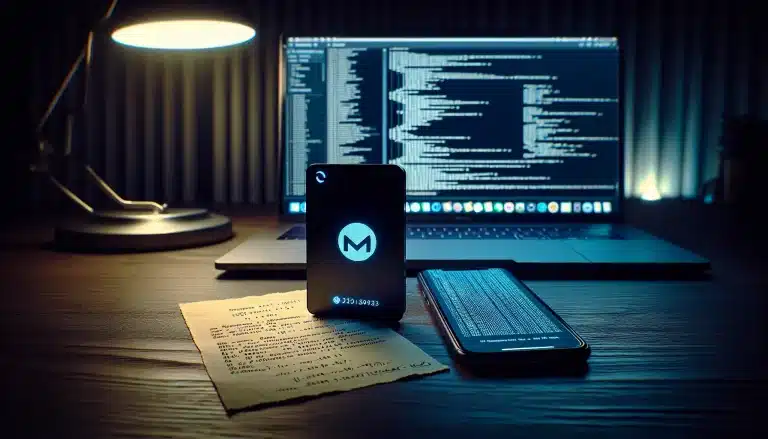Smart Contract Security Risks You Can’t Ignore
Did you know there have been over 46 reentrancy attacks just in early 2025? This number shows that smart contract security risks are a big concern in the fast-changing world of blockchain technology1. As these contracts become more common, the risk of losing a lot of money increases. This makes it crucial for those creating and investing in these technologies to be very careful.
Smart contracts do more than just run code. They’re key parts of many blockchain projects, setting the rules of the deal right in the programming. This automation means things can run really smoothly and openly. But, it also means that any security problems can have huge, costly effects1.
It’s vital to know the big security risks in smart contracts that you must watch out for. Recognizing issues like reentrancy attacks and validation errors can help keep your assets safe. To better secure your smart contracts, it’s a good idea to look into crypto security materials.
Key Takeaways
- Reentrancy attacks are becoming more common; awareness is crucial.
- Smart contracts must implement rigorous access control measures.
- Improper input validation can lead to severe vulnerabilities.
- Excessive function restrictions can result in locked funds.
- Documenting security practices is vital for effective audits.
- Ongoing education is necessary to stay updated on threats.
Understanding Smart Contracts
Smart contracts automatically enforce agreements. They’re built with code and run on blockchain tech. This cuts out middlemen, saving money and increasing speed.
But, smart contracts are not without security risks. Their complex code can have errors or be open to attacks. It’s important to understand these contracts to spot and stop risks.
As smart contracts become more common, knowing how they work is key. This lets you see possible issues early. Learning about smart contracts helps keep your assets safe.
Keeping smart contracts safe is vital. Always check their code and how they function carefully. As they become used more in business, staying informed can protect your money and projects.
| Aspect | Description | Importance |
|---|---|---|
| Cost Efficiency | Eliminates intermediary fees | Lower transaction costs |
| Automation | Executes contracts automatically upon meeting conditions | Enhances speed and accuracy |
| Transparency | All transactions are recorded on the blockchain | Increases trust and accountability |
| Security | Uses cryptographic techniques to secure data | Reduces fraud risks |
Understanding smart contracts equips you to make better decisions2. This knowledge helps safeguard your interests.
The Rise of Blockchain Technology
Blockchain technology is changing the way we handle digital transactions. Its growth is fueled by the need for decentralized apps (DApps) and an interest in cryptocurrencies. Now, ensuring transactions are secure through blockchain security best practices is key.
Seeing this potential, venture capital has poured money into Web3 developers in 2022. Many companies are now focusing on Web3. They see it as the future internet, with the goal of making things more decentralized. They plan to use artificial intelligence (AI) and machine learning (ML) for better scalability and efficiency.
At the same time, decentralized finance (DeFi) services have reshaped our finance views. People can now invest, lend, and trade cryptocurrency without needing permission. This encourages new financial models. But it also highlights the need for strong blockchain security to protect user information and transactions.
Decentralized autonomous organizations (DAOs) are leading to more democratic governance. They operate on smart contracts, reducing the need for human input or worrying about location.
With these changes, keeping up with blockchain security best practices is vital. It’s important to maintain the technology’s growth without losing trust or security. The consequences of security breaches would be severe, stressing the need for enhanced security in the blockchain world.
The excitement and caution in navigating this new field are clear. Data shows 37% of experts are more concerned than excited about upcoming technological shifts, while 42% feel both emotions equally. This cautious optimism is crucial when bringing new technologies into the blockchain area3.
Shocking Security Risks in Smart Contracts You Can’t Ignore
Smart contracts are great because they’re efficient and open. But, they’re not safe from big security risks. The smart contract world could face issues that lead to huge money losses and damaged trust. It’s vital for both creators and users to know these risks well.
Common Vulnerabilities in Smart Contracts
Smart contracts face several common problems. These include:
- Reentrancy Attacks: Attackers mess with a contract’s functions. They make a contract call itself over and over before it finishes the first time.
- Improper Access Control: This happens when contracts don’t keep tight control over who can do what. It leads to people doing things they shouldn’t.
- Reliance on External Data (Oracles): Smart contracts often need info from outside. This leaves them open to wrong or twisted data.
Historical Cases of Smart Contract Exploits
History has shown us how bad these problems can be. For example, the DAO hack in 2016 caused a shocking loss of about $50 million. This event made investors doubt the safety of smart contracts. Other incidents also show the constant danger these technologies face. It shows how crucial it is to have strict security steps to protect money.
To fight these big security issues, we must keep learning and taking action. This helps make smart contracts safer and more dependable4.
Potential Vulnerabilities in Smart Contracts
It’s vital to know the risks in smart contracts to keep them safe on the blockchain. There are many threats that can break the trust in these digital agreements. So, developers need to keep an eye out for common dangers.
Reentrancy Attacks
Reentrancy attacks are a big danger to smart contracts. They happen when a bad contract tricks the original into running again before it’s done. This can lead to stolen funds. The DAO hack showed how big of a problem this can be.
It points out the need for safe coding. Developers have to work hard to prevent these issues to make their apps more reliable.
Integer Overflow and Underflow
Integer overflow and underflow are also major issues. They happen when numbers in a contract go too high or too low. This can cause the contract to act strangely.
If numbers get too big or too small, they can flip to unexpected values. This messes up the contract’s actions. Fixing these flaws is key to keeping smart contracts secure.
Developers must understand these risks to code safely and defend their smart contracts. For more help with these challenges, check out cryptocurrency trends5.
The Impact of Poor Coding Practices
Poor coding practices can make smart contracts very unsafe. This situation leads to concerns like not enough testing. It also causes issues due to lacking documentation. These problems expose blockchain apps to big cybersecurity threats in blockchain technology.
To keep their platforms safe, smart contract developers must follow best coding standards. Ignoring these best practices affects the system’s reliability. It can result in disaster for organizations depending on blockchain for security.
| Risk Factor | Description | Potential Impact |
|---|---|---|
| Inadequate Testing | Lack of thorough testing can result in unnoticed vulnerabilities. | Exposure to exploits that can drain funds |
| Poor Documentation | Insufficient documentation makes it hard for other developers to understand the code. | Increased risk of unintentional errors and security gaps |
| Neglecting Best Practices | Failing to adhere to coding conventions can lead to security flaws. | Higher susceptibility to malicious attacks |
Smart contracts face both chances and risks as the industry grows. Your dedication to strict coding practices is key. It helps protect digital assets from dangers. To learn more about staying well in stressful times, look at how NFL players manage. For instance, Tua Tagovailoa shared his experiences here6.
Cybersecurity Threats in Blockchain Technology
Blockchain tech is changing the world but faces big cybersecurity problems. As more companies use blockchain, knowing these dangers is key to keep things safe and trusted. The main dangers are phishing, 51% attacks, and DDoS attacks. These can harm the network and its users. Cyber dangers in blockchain are real and can hit investments and operations hard.
Keeping smart contract data safe is very important. Smart contracts are public and cannot be changed, which makes them targets. Using strong encryption can protect the data inside these contracts. Learning about blockchain security is vital for developers and security pros.
Stats show Ethereum smart contracts often have around 12.3 security holes, and about 37% of these contracts face security risks7. Also, 24% can be hit by DoS attacks, and 29% could suffer from a 51% attack7. Knowing these numbers shows how crucial strong security is in fighting these threats.
Having a strong cybersecurity plan is crucial. Doing regular security checks and watching out for threats can lower risks. As threats change, learning more and putting money into safety is key for people in blockchain and smart contract development.
| Threat | Description | Pervasiveness |
|---|---|---|
| Phishing Attacks | Fraudulent attempts to obtain sensitive information | Prevalent across various platforms |
| 51% Attacks | When a single entity gains control of most mining power | 29% of Ethereum smart contracts may be vulnerable |
| DDoS Attacks | Overloading a system to disrupt services | Common in decentralized applications |
In short, blockchain technology’s cybersecurity threats are many and serious. Protecting data in smart contracts is critical. The community must work hard and smart to tackle these issues effectively8.
Importance of Blockchain Security Audits
Blockchain security audits are key in keeping smart contract applications safe and trustworthy. Before these contracts are used by people, they must be checked thoroughly. This helps find any issues and checks if they meet certain standards. By doing these audits, developers can fix problems early and make users feel more secure.
What to Expect from a Security Audit
During a security audit, experts closely examine the code to find weaknesses. They also:
- Code Review: Look through the smart contract’s code to spot potential risks.
- Pentest Simulations: Test the defenses by simulating attacks.
- Compliance Checks: Check if the smart contract follows rules and standards.
Key Audit Tools and Techniques
There are special tools that make the audit process better and more effective. Some important ones include:
| Tool | Functionality |
|---|---|
| MythX | Finds weak spots in Ethereum smart contracts through detailed checks. |
| Slither | Quickly uncovers issues in the code using a detailed review method. |
| Truffle Suite | Provides a complete set for building and testing contracts. |
Putting money and effort into these audits protects from known risks and gets teams ready for new challenges. Audits are vital for smart contract projects to succeed9. Doing them regularly builds trust with everyone involved, highlighting how crucial security audits are10.
Securing Smart Contract Applications
Securing smart contract applications needs careful attention to blockchain security. Best practices must be followed carefully. This includes testing thoroughly during development. Developers should follow coding standards to reduce risks and make updates easy.
Adding security features like multi-signature wallets helps protect your app. User access controls add another layer of security. Doing design audits early can spot weaknesses. Keeping up with new cybersecurity threats is also key. This helps everyone stay safe as threats evolve.
Using specialized security tools is crucial for keeping smart contracts safe. This way, you can watch for and defend against threats, seen and unseen. Staying dedicated to these practices lowers the chance of risks. It helps keep smart contract applications safe for everyone11.








 Bitcoin
Bitcoin  Ethereum
Ethereum  Tether
Tether  XRP
XRP  USDC
USDC  TRON
TRON  Lido Staked Ether
Lido Staked Ether  Dogecoin
Dogecoin  Figure Heloc
Figure Heloc  Cardano
Cardano  Wrapped stETH
Wrapped stETH  WhiteBIT Coin
WhiteBIT Coin  Bitcoin Cash
Bitcoin Cash  Wrapped Bitcoin
Wrapped Bitcoin  Monero
Monero  Wrapped eETH
Wrapped eETH  USDS
USDS  Chainlink
Chainlink  Binance Bridged USDT (BNB Smart Chain)
Binance Bridged USDT (BNB Smart Chain)  LEO Token
LEO Token  WETH
WETH  Coinbase Wrapped BTC
Coinbase Wrapped BTC  Stellar
Stellar  Ethena USDe
Ethena USDe  Zcash
Zcash  Sui
Sui  Hyperliquid
Hyperliquid  Avalanche
Avalanche  Litecoin
Litecoin  Hedera
Hedera  USDT0
USDT0  Shiba Inu
Shiba Inu  Dai
Dai  World Liberty Financial
World Liberty Financial  Canton
Canton  sUSDS
sUSDS  Toncoin
Toncoin  Cronos
Cronos  Ethena Staked USDe
Ethena Staked USDe  PayPal USD
PayPal USD  USD1
USD1  Polkadot
Polkadot  Uniswap
Uniswap  Rain
Rain  Mantle
Mantle  MemeCore
MemeCore  Bitget Token
Bitget Token  Aave
Aave